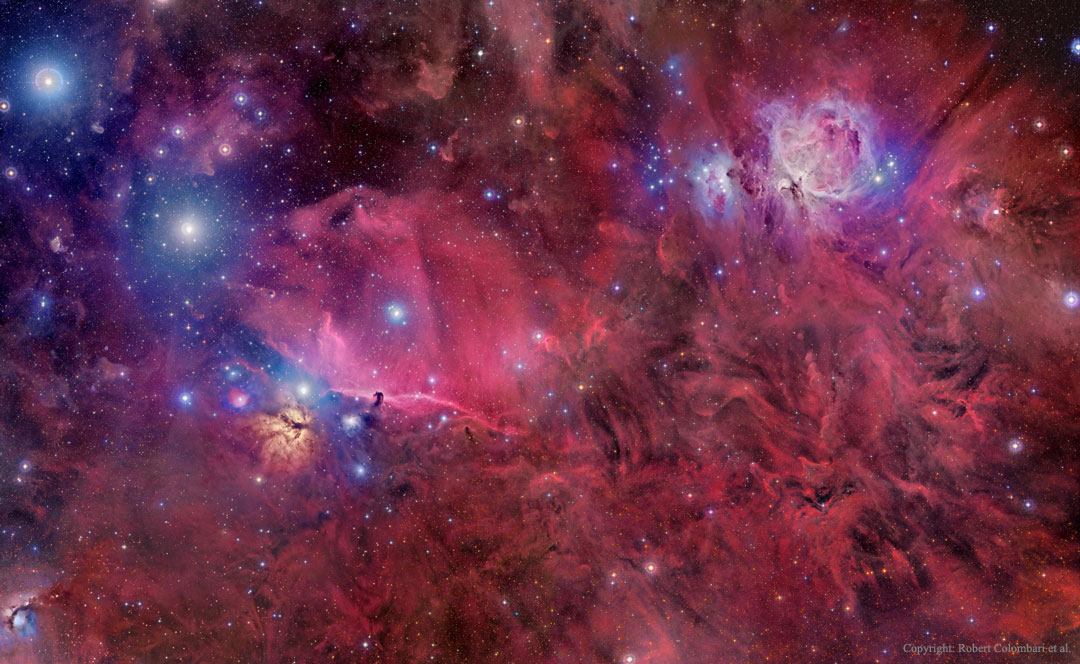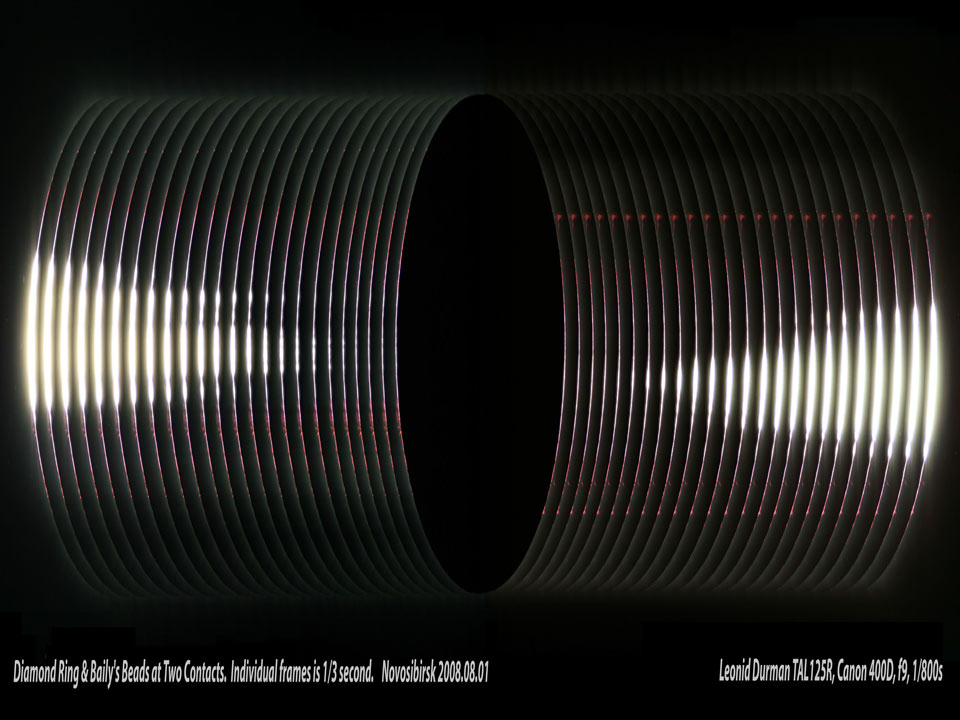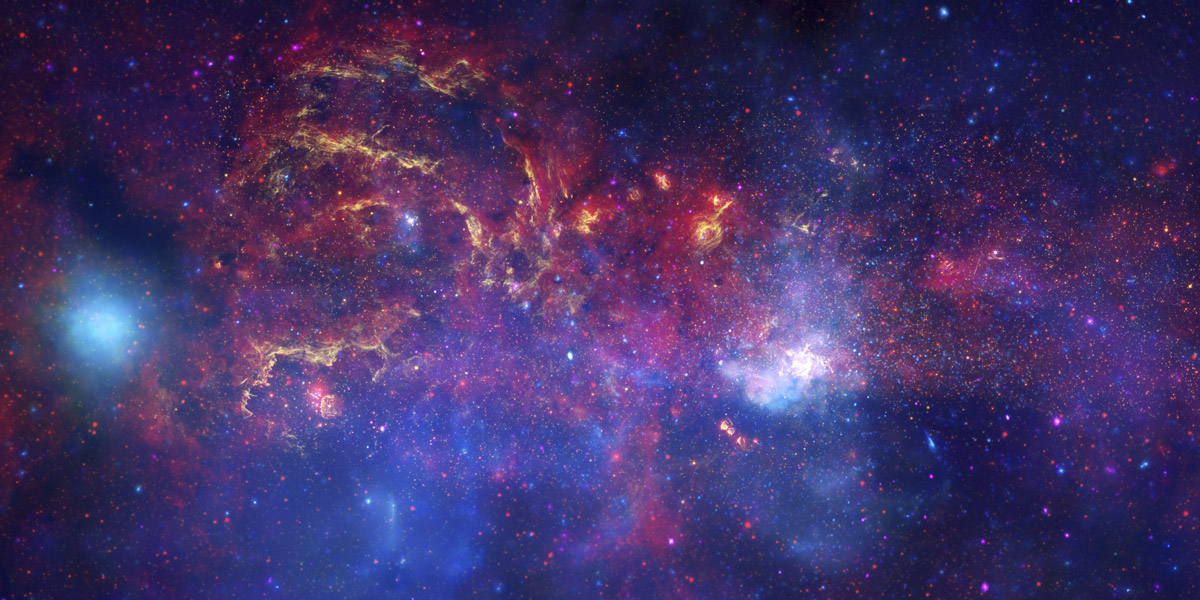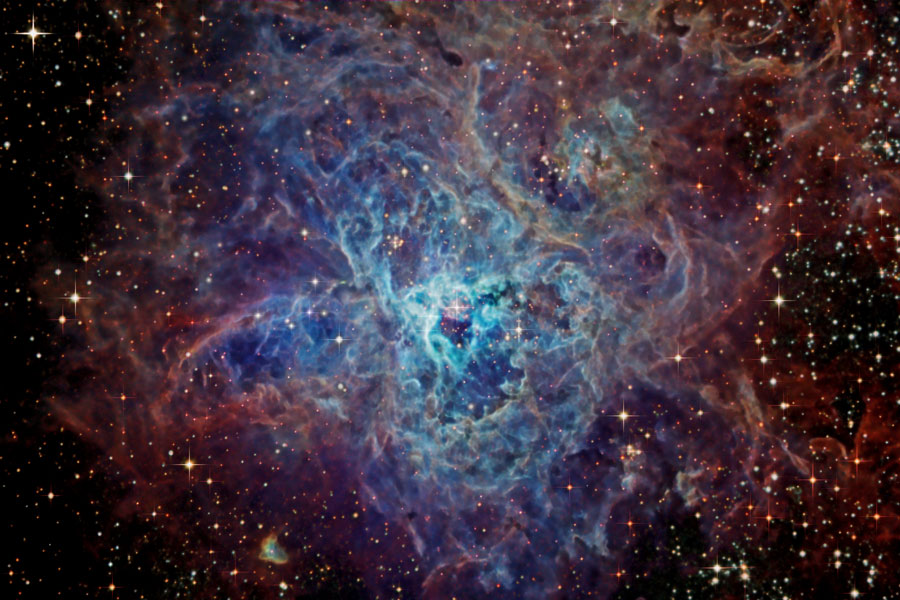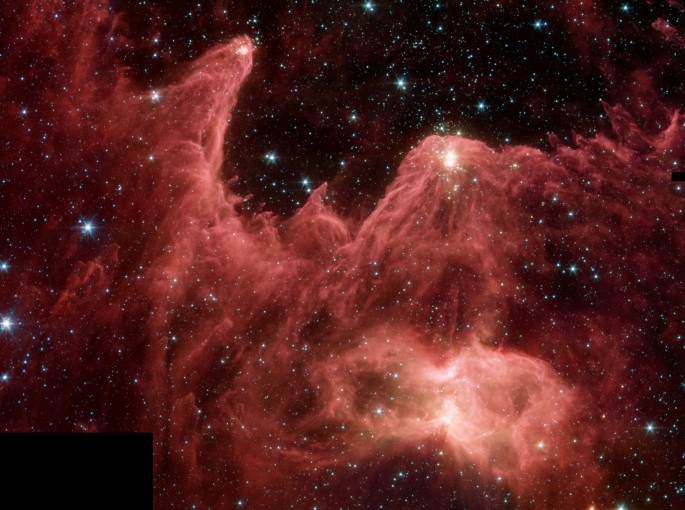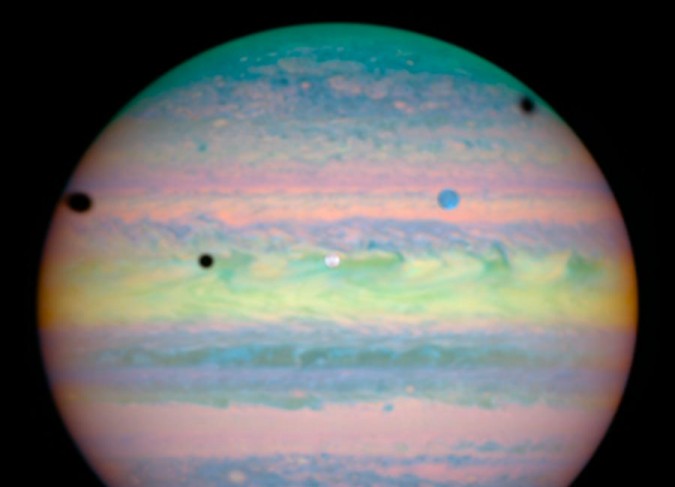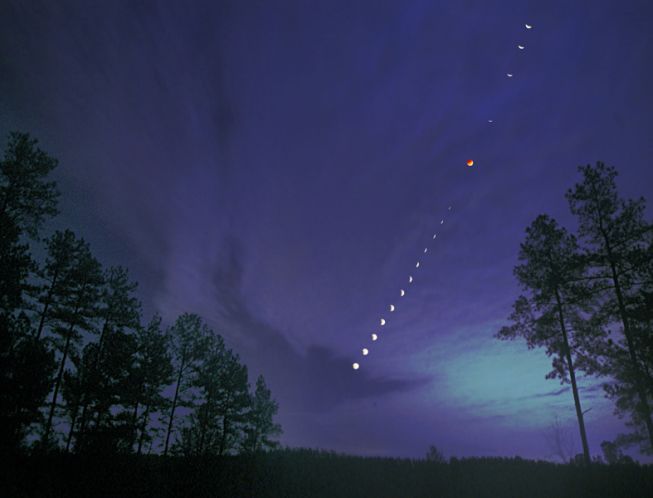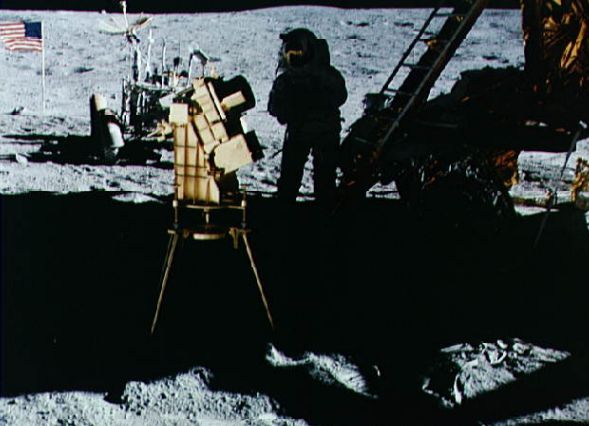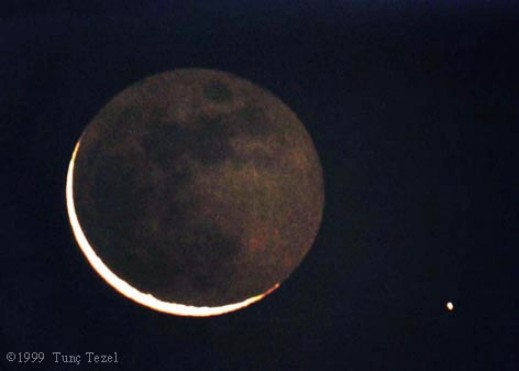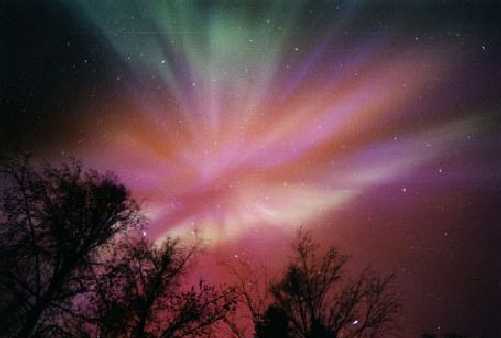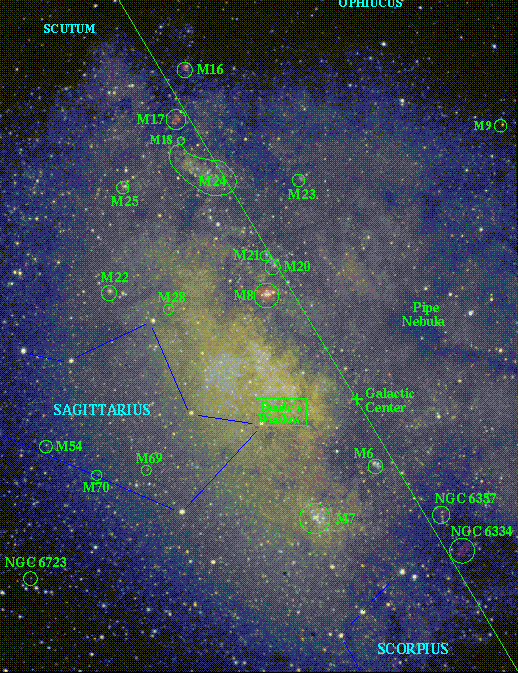| << Previous | Index | Next >> |
2014 The constellation of Orion holds much more than three stars in a row. A deep exposure shows everything from dark nebula to star clusters, all embedded in an extended patch of gaseous wisps in the greater Orion Molecular Cloud Complex. The brightest three stars on the far left are indeed the famous three stars that make up the belt of Orion. Just below Alnitak, the lowest of the three belt stars, is the Flame Nebula, glowing with excited hydrogen gas and immersed in filaments of dark brown dust. Below and left of the frame center and just to the right of Alnitak lies the Horsehead Nebula, a dark indentation of dense dust that has perhaps the most recognized nebular shapes on the sky. On the upper right lies M42, the Orion Nebula, an energetic caldron of tumultuous gas, visible to the unaided eye, that is giving birth to a new open cluster of stars. Immediately to the left of M42 is a prominent bluish reflection nebula sometimes called the Running Man that houses many bright blue stars. The featured image covers an area with objects that are roughly 1,500 light years away and spans about 75 light years.
2013
2012 Just before the Sun blacks out, something strange occurs. As the Moon moves to completely cover the Sun in a total solar eclipse -- like the one set to occur over parts of Australia on Tuesday -- beads of bright sunlight stream around the edge of the Moon. This effect, known as Baily's beads, is named after Francis Baily who called attention to the phenomenon in 1836. Although, the number and brightness of Baily's beads used to be unpredictable, today the Moon is so well mapped that general features regarding Baily's beads are expected. When a single bead dominates, it is called the diamond ring effect, and is typically seen just before totality. Pictured above, horizontally compressed, a series of images recorded Baily's beads at times surrounding the 2008 total solar eclipse visible from Novosibirsk, Russia. At the end of totality, as the Sun again emerges from behind the moon, Baily's beads may again be visible -- but now on the other side of the Moon.
2011 Big, bright, and beautiful, spiral galaxy M83 lies a mere twelve million light-years away, near the southeastern tip of the very long constellation Hydra. This cosmic close-up, a mosaic based on data from the Hubble Legacy Archive, traces dark dust and young, blue star clusters along prominent spiral arms that lend M83 its nickname, The Southern Pinwheel. Typically found near the edges of the thick dust lanes, a wealth of reddish star forming regions also suggest another popular moniker for M83, The Thousand-Ruby Galaxy. Dominated by light from older stars, the bright yellowish core of M83 lies at the upper right. The core is also bright at x-ray energies that reveal a high concentration of neutron stars and black holes left from an intense burst of star formation. In fact, M83 is a member of a group of galaxies that includes active galaxy Centaurus A. The close-up field of view spans over 25,000 light-years at the estimated distance of M83.
2010 Venus rose in a glowing dawn sky on November 5th, just before the Sun. For early morning risers, its brilliant crescent phase was best appreciated with binoculars or a small telescope. On that day the crescent Venus also appeared in close conjunction with another lovely crescent that hugs the eastern horizon in planet Earth's morning skies, the waning crescent Moon. The celestial photo-op is captured here from two locations. Left, separated by less than a degree, the two crescents hover above a sea of clouds. The picture was recorded from an Alpine mountain pass not far from Turin, Italy. On the right is a sharp telephoto view taken before an earlier sunrise, farther east in the Alborz Mountains of Iran. In steady skies the slender Moon is still sliding toward Venus, the bright planet's compact crescent just clearing the mountainous horizon. For now, the crescent phase of Venus remains easy to enjoy with binoculars in November's dawn skies. The first observations of the phases of Venus, made by Galileo with his telescope in 1610, agreed with the predictions of the heliocentric Copernican model of the Solar System.
2009 Where can a telescope take you? Four hundred years ago, a telescope took Galileo to the Moon to discover craters, to Saturn to discover rings, to Jupiter to discover moons, to Venus to discover phases, and to the Sun to discover spots. Today, in celebration of Galileo's telescopic achievements and as part of the International Year of Astronomy, NASA has used its entire fleet of Great Observatories, and the Internet, to bring the center of our Galaxy to you. Pictured above, in greater detail and in more colors than ever seen before, are the combined images of the Hubble Space Telescope in near-infrared light, the Spitzer Space Telescope in infrared light, and the Chandra X-ray Observatory in X-ray light. A menagerie of vast star fields is visible, along with dense star clusters, long filaments of gas and dust, expanding supernova remnants, and the energetic surroundings of what likely is our Galaxy's central black hole. Many of these features are labeled on a complementary annotated image. Of course, a telescope's magnification and light-gathering ability create only an image of what a human could see if visiting these places. To actually go requires rockets.
2008 First cataloged as a star, 30 Doradus is actually an immense star forming region in nearby galaxy The Large Magellanic Cloud. The region's spidery appearance is responsible for its popular name, the Tarantula nebula, except that this tarantula is about 1,000 light-years across, and 180,000 light-years away in the southern constellation Dorado. If the Tarantula nebula were at the distance of the Orion Nebula (1,500 light-years), the nearest stellar nursery to Earth, it would appear to cover about 30 degrees (60 full moons) on the sky. The spindly arms of the Tarantula nebula surround NGC 2070, a star cluster that contains some of the brightest, most massive stars known. Intriguing details of the nebula are visible in this scientifically-colored image. The cosmic Tarantula also lies near the site of the closest recent supernova.
2007 What caused the Crescent Nebula? Looking like an emerging space cocoon, the Crescent Nebula, visible in the center of the above image, was created by the brightest star in its center. A leading progenitor hypothesis has the Crescent Nebula beginning to form about 250,000 years ago. At that time, the massive central star had evolved to become a Wolf-Rayet star (WR 136), shedding its outer envelope in a strong stellar wind, ejecting the equivalent of our Sun's mass every 10,000 years. This wind impacted surrounding gas left over from a previous phase, compacting it into a series of complex shells, and lighting it up. The Crescent Nebula, also known as NGC 6888, lies about 4,700 light-years away in the constellation of Cygnus. Star WR 136 will probably undergo a supernova explosion sometime in the next million years.
2006 Follow the handle of the Big Dipper away from the dipper's bowl, until you get to the handle's last bright star. Then, just slide your telescope a little south and west and you might find this stunning pair of interacting galaxies, the 51st entry in Charles Messier's famous catalog. Perhaps the original spiral nebula, the large galaxy with well defined spiral structure is also cataloged as NGC 5194. Its spiral arms and dust lanes clearly sweep in front of its companion galaxy (right), NGC 5195. The pair are about 31 million light-years distant and officially lie within the boundaries of the small constellation Canes Venatici. Though M51 looks faint and fuzzy in small, earthbound telescopes, this sharpest ever picture of M51 was made in January 2005 with the Advanced Camera for Surveys on board the Hubble Space Telescope.
2005 This fantastic skyscape lies at the eastern edge of giant stellar nursery W5, about 7,000 light-years away in the constellation Cassiopeia. An infrared view from the Spitzer Space Telescope, it features interstellar clouds of cold gas and dust sculpted by winds and radiation from a hot, massive star outside the picture (just above and to the right). Still swaddled within the cosmic clouds, newborn stars are revealed by Spitzer's penetrating gaze, their formation also triggered by the massive star. Fittingly dubbed "Mountains of Creation", these interstellar clouds are about 10 times the size of the analogous Pillars of Creation in M16, made famous in a 1995 Hubble Space Telescope view. W5 is also known as IC 1848 and together with IC 1805 it is part of a complex region popularly dubbed the Heart and Soul Nebulae. The Spitzer image spans about 70 light-years at the distance of W5.
2004 This false-color image of banded gas giant Jupiter shows a triple eclipse in progress on March 28 - a relatively rare event, even for a large planet with many moons. Captured by the Hubble Space Telescope's near-infrared camera are shadows of Jupiter's moons Ganymede (left edge), Callisto (right edge) and Io, three black spots crossing the sunlit Jovian cloud tops. In fact, Io itself is visible as a white spot near picture center with a bluish Ganymede above and to the right, but Callisto is off the right hand edge of the scene. Viewed from Jupiter's perspective, these shadow crossings would be seen as solar eclipses, analogous to the Moon's shadow crossing the sunlit face of planet Earth. Historically, timing the eclipses of Jupiter's moons allowed astronomer Ole Roemer to make the first accurate measurement of the speed of light in 1676.
2003 Happily, skies over Connelly's Springs, North Carolina, USA were not mostly cloudy, as forecast, on the evening of November 8. In fact they were mostly clear early on, allowing photographer David Cortner to record the evening's scheduled celestial entertainment, a total lunar eclipse. Cortner took telescopic pictures of the Moon every eight minutes as it entered partial eclipse around 6:30pm EST and progressed through the reddish total eclipse phase while rising higher in the sky. Near the end of the eclipse he also recorded a wide-angle view in a long exposure, bringing out the thickening clouds and a landscape silhouetted by still partially eclipsed moonlight. Later, the telescopic views were carefully combined along the Moon's trail through the wide-angle image to create this dramatic composite eclipse sequence.
2002 What causes the surrounding shells in peculiar galaxy Cen A? Last month a fascinating image of peculiar galaxy Centaurus A was released, processed to highlight a faint blue arc indicating an ongoing collision with a smaller galaxy. Another interesting feature of Cen A, however, is the surrounding system of shells, better visible here in this recently released wider pan from the four meter Blanco telescope at Cerro Tololo Inter-American Observatory. Faint shells around galaxies are not unusual and considered by themselves as evidence of a previous galaxy merger, analogous to water ripples on a pond. An unexpected attribute of these shells is the abundance of gas, which should become separated from existing stars during the collision.
2001 The 1998 Leonids Meteor Shower was one of the most photographed meteor events in history. Patient observers saw bright meteors streak across dark skies every few minutes, frequently leaving fading trails stretching across the sky. High above the Anza-Borrego Desert, a meteor was photographed streaking up from the radiant constellation of the Leonids: Leo. This meteor train covered over 40 degrees, and changed colors from green to red. The intensity of the Leonid Meteor Shower in 2001 is uncertain but may approach one per second for some locations on November 18.
2000 The first, and so far only, lunar astronomical observatory was deployed by the Apollo 16 crew in 1972. The Far Ultraviolet Camera / Spectrograph used a 3-inch diameter Schmidt telescope to photograph the Earth, nebulae, star clusters, and the Large Magellanic Cloud. The tripod mounted astronomical equipment is seen above, placed in the shadow of the Lunar Module (right) so it would not overheat. Also in the shadow is astronaut Charles Duke with the lunar rover in the background. The Far Ultraviolet Camera took pictures in ultraviolet light which would normally be blocked by the Earth's atmosphere. It was created by George Carruthers (NRL), had a field of view of twenty degrees, and could detect stars having visual magnitude brighter than eleven. One hundred seventy-eight images were recorded in a film cartridge which the astronauts returned to Earth. The observatory still stands on the Moon today.
1999 Mercury is the closest planet to the Sun and never moves far from our parent star in Earth's sky. Racing around its tight orbit, this well-done world is a little over 1/3 the diameter of Earth and is often lost to our view in the solar glare. But, just one day before the August 11 total solar eclipse, astronomer Tunc Tezel captured this fleeting view of a close conjunction of Mercury and the soon to be silhouetted Moon as seen from Turkey. Mercury at the lower right shines brightly in reflected sunlight while only a thin crescent of the almost new Moon is directly illuminated. The rest of the lunar nearside is faintly visible though, illuminated by light from an almost full Earth. On Monday, November 15th, Mercury will actually be seen to transit or pass across the disk of the Sun for well placed observers in the pacific hemisphere.
1998 On some nights the sky is the most interesting show in town. This picture captures a particularly active and colorful display of aurora that occurred a month ago high above Alaska. Auroras are more commonly seen by observers located near the Earth's poles. Aurora light results from solar electrons and protons striking molecules high in the Earth's atmosphere. Planetary aurora activity can sometimes be predicted after particularly active solar coronal mass ejections.
1997 The sky toward the center of our Galaxy is filled with a wide variety of celestial wonders. Most are visible with only binoculars. Constellations of nearby stars include Sagittarius, Libra, Scorpius, Scutum, and Ophiuchus. Nebulae include Messier Objects M8, M16, M17, M20 and the Pipe Nebula. Open clusters include M6, M7, M18, M21, M23, M24, M25. Globular clusters include M9, M22, M28, M54, M69, M70. And don't forget Baade's Window. Click on the photo to get the un-annotated version.
1996
1995 Recently two new types of lightning have been verified: red sprites and blue jets. These atmospheric discharges occur very high in the Earth's atmosphere - much higher than the familiar form of lightning. Red sprites appear red in color and go from the tops of clouds to as high as the ionosphere - an ionized layer 90 kilometers above the Earth's surface. They last only a small fraction of a second. The existence of red sprites has been suggested previously, but only in 1994 were aircraft flown above massive thunderstorms with the high speed video equipment necessary to verify these spectacular events. Scientists are unsure of the cause and nature of red sprites.
| << Previous | Index | Next >> |
